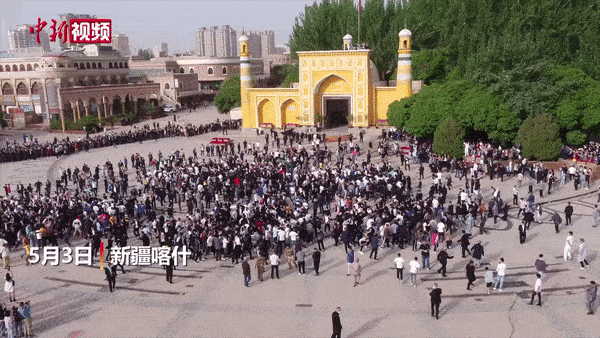Xinjiang officials said to pay Uyghurs to perform dance at Kashgar mosque
May 05, 2022Authorities in Kashgar allegedly paid Muslim Uyghur men to dance outside the most famous mosque in northwestern China’s Xinjiang region to celebrate the end of Ramadan, a performance that was filmed and released by state media ahead of an anticipated visit by the United Nations human rights chief later this month.
Kashgar locals told RFA that people were not allowed to pray at Id Kah Mosque but instead were organized to dance on Eid al-Fitr on May 3, as shown in a YouTube video posted by China News Service (Zhongxinwang) on Tuesday. Chinese tourists can been seen observing the dancing and taking photos in the square.
A police officer from the city’s Kumdarwaza police station told RFA that prayers have not been allowed at the Id Kah Mosque since 2016. The dance was organized by residential committees, Chinese Communist Party organizations that oversee neighborhood units in cities and towns across China, he said.
“Several of our colleagues went to the square and met residential committee officials, and they told them that they had brought people to perform the Sama,” the officer, who did not provide his name, said.
The Muztagh and Donghu residential committees sent about 500-600 people to perform the Sama, the officer added.
“Several weeks before the festival, the residential committees created a list with the names of those who would attend the Sama,” he said. “On one list, I saw there were four to five people I knew on one floor of our building.”
…
The Donghu residential committee paid 120-150 yuan (U.S. $18-23) to those who went to Kashgar to perform the dance because it would take them at least half a day, the police officer said. A typical worker in Kashgar earns about 250-300 yuan a day.
The Muztagh residential committee did not pay the Uyghurs, who comprise 90% of the residents in the community, to dance, he said.
“No one can reject the demands of the residential committees, especially in the communities where Uyghurs live,” the officer said.
“I watched the video, and I guess some people missed the Sama dance because they haven’t danced it for six years,” he said. “Some people try to show themselves as being alive and happy — that’s what the residential committees want.
“Moreover, after 2017, people became worried about approaching the mosque,” he added. “There is no such thing as running to Sama now. That’s why they paid them.”
